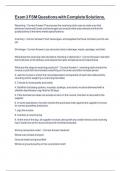Exam 3 FSM Questions with Complete Solutions.
Receiving - Correct Answer The process the receiving clerk uses to make sure that
delivered (received) foods and beverages are exactly what was ordered and that the
quality/safety of the items meets specifications.
Inventory - Correct Answer Food, beverages, and supplies that have not been put into use
yet.
Shrinkage - Correct Answer Loss of product due to damage, waste, spoilage, and theft.
What does the receiving clerk do before checking in deliveries? - Correct Answer note both
the timeliness of the delivery and assess the trailer temperature and cleanliness
What are the steps to receiving products? - Correct Answer 1. receiving clerk checks the
invoice or pick list that includes everything on the order and often includes prices
2. use the invoice to check the name/description and quantity of each item delivered by
counting and/or weighing or scanning barcodes.
3. Checks for food quality and safety
4. Shellfish (including oysters, mussels, scallops, and clams) must be delivered with a
shellfish identification tag Hold for 90 days.
5. If the food service does not accept an item on the invoice, that item is returned to the
supplier.
6. In some operations, the clerk checks the purchase order against the supplier's invoice
for correct quantities and prices.
7. sign the invoice
8. maintain a receiving log
9. At the end of the day, all supplier invoices (along with any credit memos) and receiving
log (if used) are sent to accounting to be reviewed and paid.
Storing raw protein order. - Correct Answer Seafood
Whole cuts of beef and pork
Ground meats and groundfish
Whole or ground poultry on the very bottom shelf
, (based on min internal cooking temp.)
Storage temp for dry storage areas - Correct Answer 50 -70 degrees F
Freezers - Correct Answer at or below 0 degrees F (-18 C)
Accuracy of thermometer in storage area - Correct Answer accurate within +/- 3 F (+/-1.5
C)
What fruits and vegetables do not need refrigeration? - Correct Answer potatoes, sweet
potatoes, onions, garlic, winter squash, beets, pineapple, and bananas
Why do you need to keep onions away from other foods? - Correct Answer may absorb
odors such as butter, cheese, milk, and cake frosting.
What are some Ethylene sensitive produce? - Correct Answer Asparagus, brussels
sprouts, broccoli, cabbage, cauliflower, mushrooms, radishes, peppers, summer squash,
cucumbers, green beans, okra, lettuce, corn, spinach, herbs, fresh-cut produce carrots
What are some Ethylene-producing fruits? - Correct Answer Lemons, limes, mangoes,
pineapple, tomatoes, avocado, watermelon, honeydew, grapefruit, oranges, tangerines,
cantaloupe, mandarin oranges, pears, plums, berries, apples, nectarines, peaches
Why is it important to keep inventory levels low? - Correct Answer Space costs money,
time to count inventory, spoilage (waste), excess may encourage theft, ties up money
Physical inventory - Correct Answer Someone counts up every item in inventory and
makes a record of it.
Perpetual inventory - Correct Answer The foodservice keeps a record of every item in
stock and records when new items are received and when an item is removed from storage
and used in the kitchen (employees fill out a Requisition Form).
How to calculate the dollar value of each inventory item - Correct Answer Item amount ×
Item cost = Item inventory value
How to calculate cost of goods sold - Correct Answer Beginning inventory + Food
purchased − Ending inventory = Food cost




